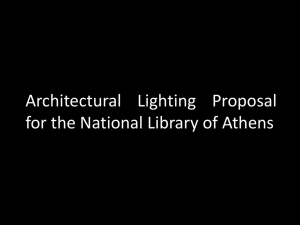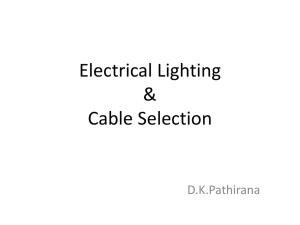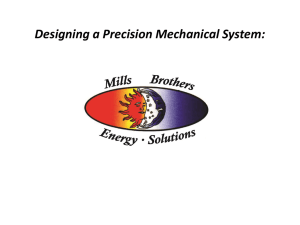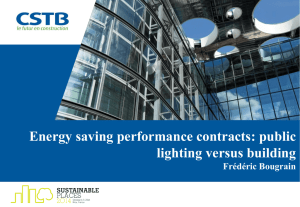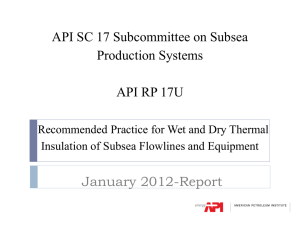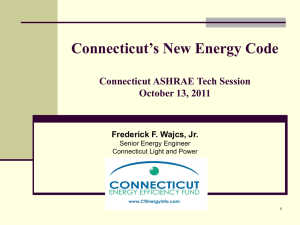T-24 Calif Building Energy Efficiency Standards Low
advertisement
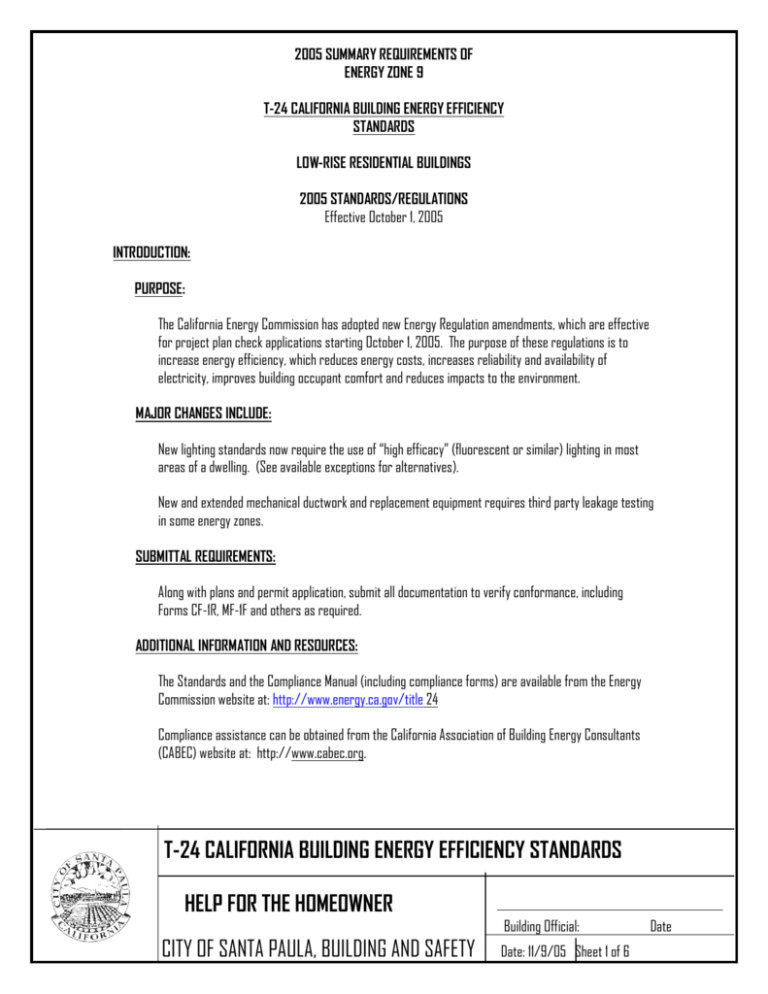
2005 SUMMARY REQUIREMENTS OF ENERGY ZONE 9 T-24 CALIFORNIA BUILDING ENERGY EFFICIENCY STANDARDS LOW-RISE RESIDENTIAL BUILDINGS 2005 STANDARDS/REGULATIONS Effective October 1, 2005 INTRODUCTION: PURPOSE: The California Energy Commission has adopted new Energy Regulation amendments, which are effective for project plan check applications starting October 1, 2005. The purpose of these regulations is to increase energy efficiency, which reduces energy costs, increases reliability and availability of electricity, improves building occupant comfort and reduces impacts to the environment. MAJOR CHANGES INCLUDE: New lighting standards now require the use of “high efficacy” (fluorescent or similar) lighting in most areas of a dwelling. (See available exceptions for alternatives). New and extended mechanical ductwork and replacement equipment requires third party leakage testing in some energy zones. SUBMITTAL REQUIREMENTS: Along with plans and permit application, submit all documentation to verify conformance, including Forms CF-1R, MF-1F and others as required. ADDITIONAL INFORMATION AND RESOURCES: The Standards and the Compliance Manual (including compliance forms) are available from the Energy Commission website at: http://www.energy.ca.gov/title 24 Compliance assistance can be obtained from the California Association of Building Energy Consultants (CABEC) website at: http://www.cabec.org. T-24 CALIFORNIA BUILDING ENERGY EFFICIENCY STANDARDS HELP FOR THE HOMEOWNER Building Official: CITY OF SANTA PAULA, BUILDING AND SAFETY Date: 11/9/05 Sheet 1 of 6 Date 2005 SUMMARY REQUIREMENTS OF ENERGY ZONE 9 Third-party diagnostic testing or field verification of energy efficient systems or devices (HERS raters) can be obtained by calling (800) 772-3300 or quering the Energy Commission website at: http://www.energy.ca.gov The following information is a summary of the new regulations. Designers, architects and engineers should obtain and refer to the current “2005 Standards” when designing new projects. Current changes are in italics. See the corresponding code sections in the “2005 Standards” for complete wording and the “2005 Residential Compliance Manual” for applications. T-24 CALIFORNIA BUILDING ENERGY EFFICIENCY STANDARDS HELP FOR THE HOMEOWNER Building Official: CITY OF SANTA PAULA, BUILDING AND SAFETY Date: 11/9/05 Sheet 2 of 6 Date 2005 SUMMARY REQUIREMENTS OF ENERGY ZONE 9 MANDATORY FEATURES AND DEVICES (Applicable to all new construction, additions and alterations) Section 150 (a) Ceiling Insulation – No change 1. R-19 minimum insulation required. A. Prescriptive Standards require: Zone 9 – R30 B. Higher values may be required by Performance calculations. (b) Loose-fill Insulation – No change (c) Wall Insulation – No change 1. R-13 minimum insulation required. A. Prescriptive Standards require: Zone 9 – R13 B. Higher values may be required by Performance calculations. (d) Raised-floor Insulation – No change 1. R-13 minimum insulation required. A. Prescriptive Standards require: Zone 9-R19 B. Higher values may be required by Performance calculations. (e) Installation of Fireplaces, Decorative Gas Appliances and Gas Logs – No Change 1. If masonry fireplace installed, it shall have the following: A. Closeable metal or glass doors covering the entire opening of the firebox. B. A combustion air intake to draw air from the outside directly into the firebox, which is at least six square inches in area and is equipped with a damper. C. A. flue damper with a readily accessible control. (f) Air Retarding Wrap – New requirements takes the place of “Infiltration Barrier”. May be required by Performance Standards. T-24 CALIFORNIA BUILDING ENERGY EFFICIENCY STANDARDS HELP FOR THE HOMEOWNER Building Official: CITY OF SANTA PAULA, BUILDING AND SAFETY Date: 11/9/05 Sheet 3 of 6 Date 2005 SUMMARY REQUIREMENTS OF ENERGY ZONE 9 (g) Vapor Barriers – No change. Applicable only in Climate Zones 14 and 16. (h) Space-conditioning Equipment – Minor changes in the use and determination of heating and cooling (i) Setback Thermostats – Required. No change. (j) Water System Pipe and Tank Insulation and Cooling Systems Line Insulation – Minor change to the loads. water piping and cooling system line insulation. 1. Storage tank insulation. No change. A. Storage gas water heaters with an energy factor <0.58 shall be externally wrapped with insulation having an installed thermal resistance of R-12 or greater. 2. Water piping and cooling system line insulation thickness and conductivity Applies to piping for recirculating systems; the first five feet of hot and cold water pipes from the storage tank for nonrecirculating system; and cooling system lines. A. Insulation to be per Table 150-A & 150-B. (k) Residential Lighting – Major changes to the use and application of lighting. 1. High Efficacy Luminaires. High Efficacy luninaires for residential lighting shall contain only high efficacy lamps (no medium screw base E24/E26). See exception reuse of high intensity discharge luminaries for outdoor lighting. 2. Lighting in Kitchens. Permanently installed luminaries in kitchens shall be high efficacy luminaries. EXCEPTION: Up to 50 percent of the total rated wattage of permanently installed luminaries in kitchens may be in luminaries that are not high efficacy luminaries, provided that these luminaries are controlled by switches separate from those controlling the high efficacy luminaries. 3. Lighting in Bathroom, Garages, Laundry Rooms and Utility Rooms. Permanently installed luminaries in bathrooms, garage, laundry rooms and utility rooms shall be high efficacy luminaries. T-24 CALIFORNIA BUILDING ENERGY EFFICIENCY STANDARDS HELP FOR THE HOMEOWNER Building Official: CITY OF SANTA PAULA, BUILDING AND SAFETY Date: 11/9/05 Sheet 4 of 6 Date 2005 SUMMARY REQUIREMENTS OF ENERGY ZONE 9 EXCEPTION: Permanently installed luminaries that are not high efficacy shall be allowed provided that they are controlled by a certified occupant sensor (s). Such motion sensors shall not have a control that allows the luminaire to be turned on automatically or that has an override allowing the luminaire to be always on. 4. Lighting other than in Kitchens, Bathrooms, Garages, Laundry Rooms and Utility Rooms. Permanently installed luminaries locate other than in kitchens, bathrooms, garages, laundry rooms and utility rooms shall be high efficacy luminaries. EXCEPTION 1: Permanently installed luminaries that are not high efficacy luminaries shall be allowed provided they are controlled by a dimmer switch. EXCEPTION 2: Permanently installed luminaries that are not high efficacy shall be allowed provided that they are controlled by a certified occupant sensor(s). Such motion sensors shall not have a control that allows the luminaire to be turned on automatically or that has an override allowing the luminaire to be always on. EXCEPTION 3: Permanently installed luminaries that are not high efficacy luminaries shall be allowed in closets less than 70 square feet. NOTE: Lighting in areas adjacent to the kitchen, including but not limited to dining and nook areas, are considered kitchen lighting if they are not separately switched from kitchen lighting. 5. Recessed Luminaires in Insulated Ceilings. Luminaires recessed into insulated ceilings shall be approved for zero clearance insulation cover (IC); shall be air tight (AT); and shall be sealed with a gasket or caulked between housing and ceiling. 6. Outdoor Lighting. Luminaires providing outdoor lighting and permanently mounted to a residential building shall be high efficacy luminaries. See exceptions. 7. Parking Lots and Garages. Only applicable to parking lots or garages for eight or more vehicles. 8. Common Areas of Low-rise Residential Buildings. Only applies to four or more units. (l) Slab Edge Insulation – Minor change to the water absorption rate. Usually not used in Zone 9. T-24 CALIFORNIA BUILDING ENERGY EFFICIENCY STANDARDS HELP FOR THE HOMEOWNER Building Official: CITY OF SANTA PAULA, BUILDING AND SAFETY Date: 11/9/05 Sheet 5 of 6 Date 2005 SUMMARY REQUIREMENTS OF ENERGY ZONE 9 Air-distribution System Ducts, Plenums, and Fans – Minor changes and continued (previous) use of mechanical fasteners and sealing systems. (m) 1. CMC Compliance. Supply and return-air ducts and plenums shall be insulated to a minimum level of R4.2. Connections of metal ducts and inner core of flexible ducts shall be mechanically fastened. Openings shall be sealed with mastic, tape, or other duct-closure system or aerosol sealant that meets the requirements of UL 723. If mastic or tape is used to seal openings greater than 1/4 inch, the combination of mastic and either mesh or tape shall be used. 2. Factory-fabricated duct systems and closure systems. Must meet UL 181 for duct sealing and closure. 3. Field-fabricated duct systems. A. All pressure-sensitive tapes, mastics, aerosol sealants, or other closure systems used for installing field-fabricated duct systems shall meet UL 181, UL 181A or UL 181B. B. Mastic sealants and mesh. UL 181. C. Pressure-sensitive tape. UL 181. D. Joints and seams of duct systems and their components shall not be sealed with cloth back rubber adhesive duct tapes unless such tape is used in combination with mastic and drawbands. E. Drawbands used with flexible duct: i. Drawbands shall be either stainless-steel worm-drive hose clamps or UV-resistant nylon duct ties. ii. Drawbands shall have a minimum tensile strength rating of 150 pounds. iii. Drawbands shall be tightened as recommended. F. Aerosol-sealant closures. i. Aerosol sealants shall meet UL 723. 4. Porous Inner Core Flex Duct shall not be used. T-24 CALIFORNIA BUILDING ENERGY EFFICIENCY STANDARDS HELP FOR THE HOMEOWNER Building Official: CITY OF SANTA PAULA, BUILDING AND SAFETY Date: 11/9/05 Sheet 6 of 6 Date
